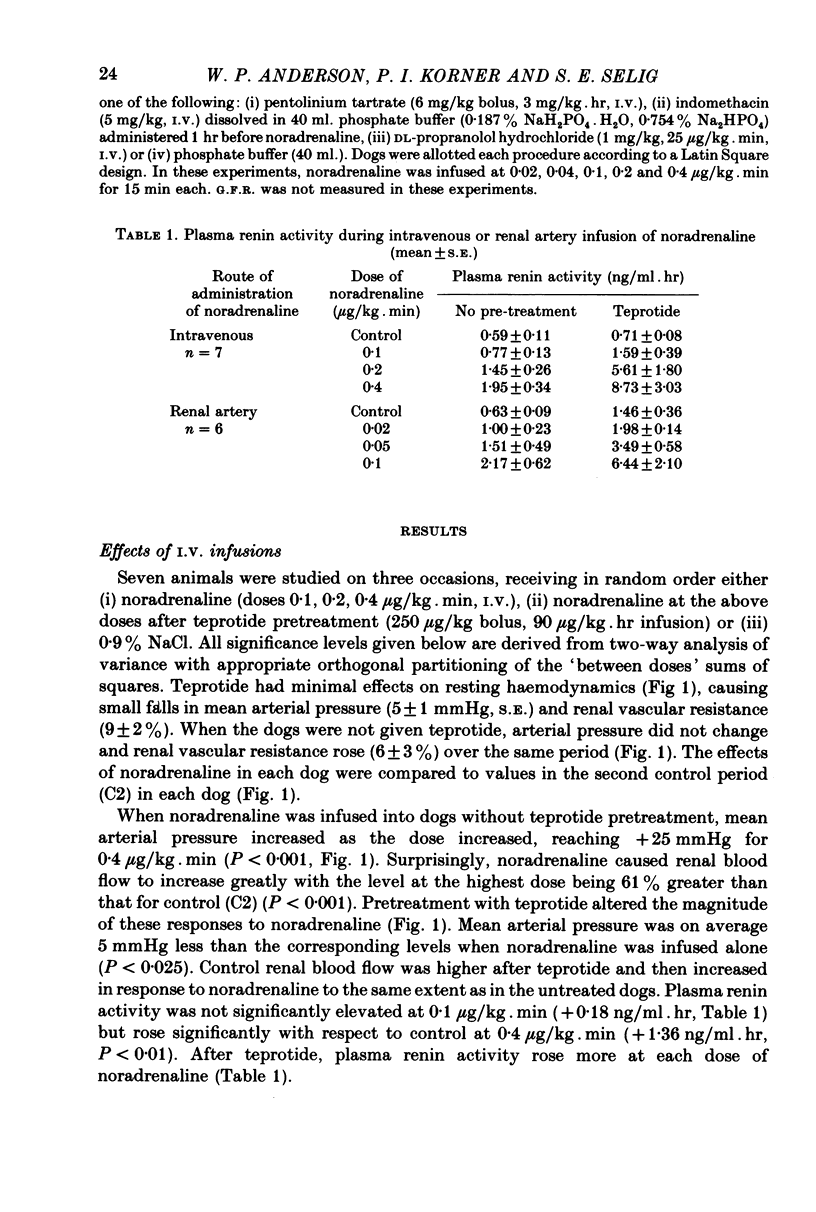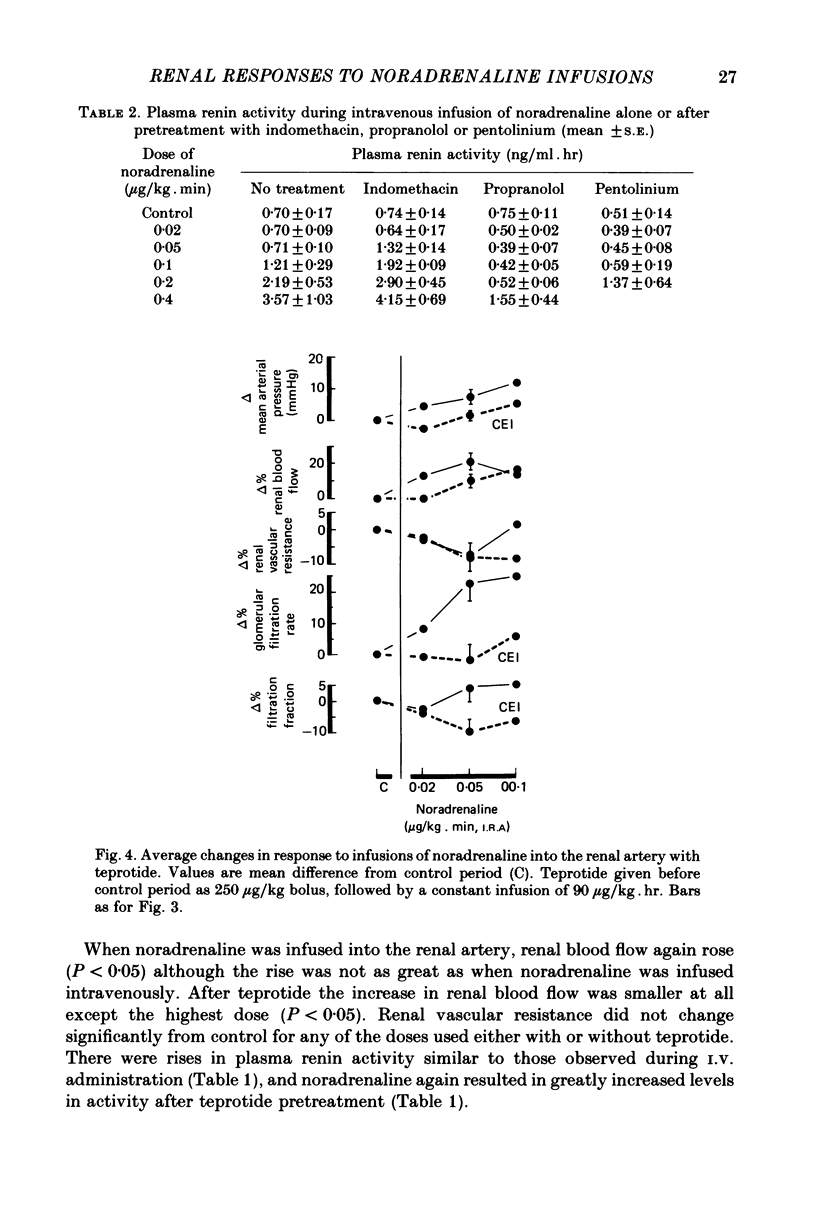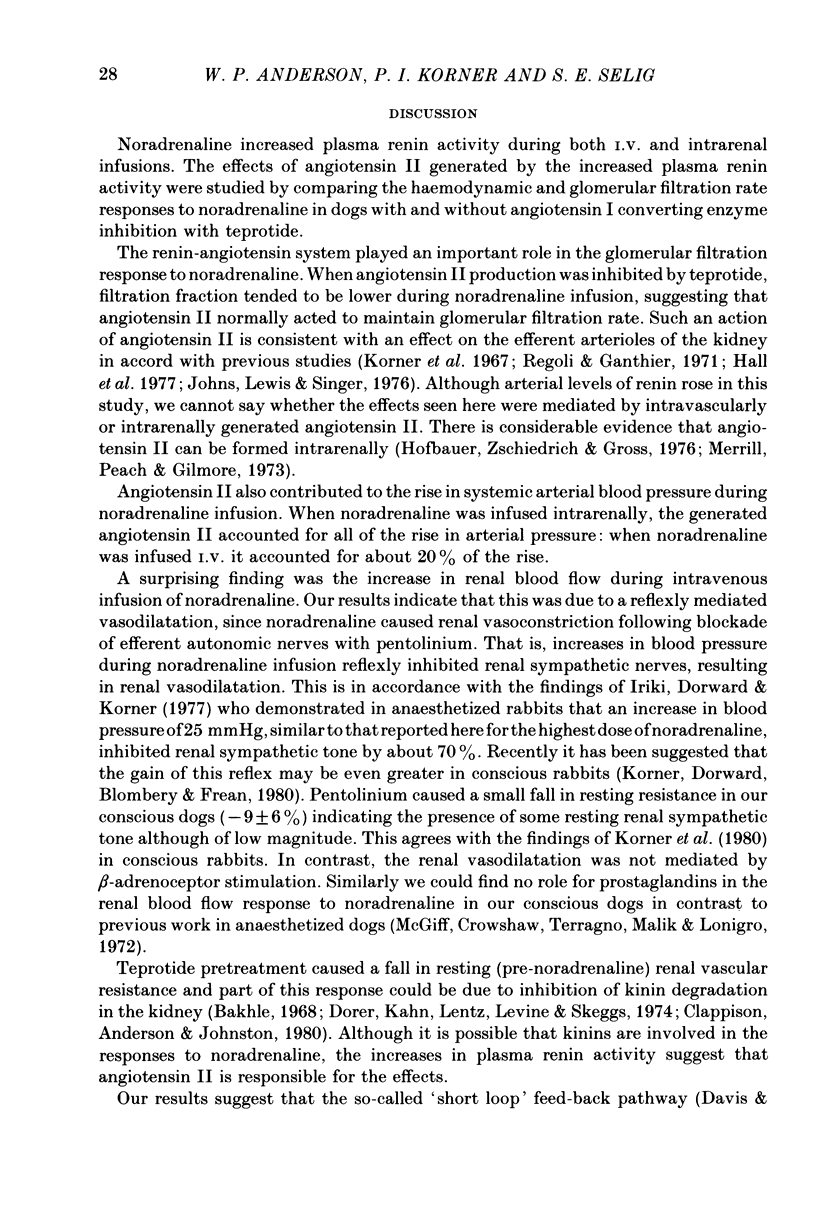Abstract
1. The renal haemodynamic and glomerular filtration rate (G.F.R.) responses to intravenous and intrarenal infusions of noradrenaline were studied in conscious dogs, either with or without prior blockade of angiotensin II formation with teprotide. 2. Infusion noradrenaline by either route resulted in dose-related rises in plasma renin activity. 3. Pretreatment with teprotide reduced the rise in mean arterial pressure and abolished the rise in G.F.R. seen during intravenous infusions of noradrenaline (0.1, 0.2 and 0.4 microgram/kg . min). Noradrenaline also reduced filtration fraction more after teprotide pretreatment. 4. Renal blood flow rose and renal vascular resistance fell in response to I.V. noradrenaline infusions. This renal vasodilatation was unaffected by pretreatment of the dogs with teprotide, indomethacin or DL-propranolol. However after pentolinium pretreatment, I.V. noradrenaline infusion caused a dose-related renal vasoconstriction. 5. Infusion of noradrenaline into the renal artery (0.02, 0.05 and 0.1 microgram/kg . min) resulted in rises in mean arterial pressure and G.F.R. which were abolished by teprotide pretreatment. Filtration fraction rose when noradrenaline was administered alone but fell when it was infused after teprotide treatment. 6. Thus angiotensin II formed as the result of increased renin release acted to maintain G.F.R. and filtration fraction during noradrenaline infusion. In addition, I.V. noradrenaline infusions in conscious dogs caused reflex vasodilatation of the renal vasculature.
Full text
PDF









Selected References
These references are in PubMed. This may not be the complete list of references from this article.
- Anderson W. P., Johnston C. I., Korner P. I. Acute renal haemodynamic and renin-angiotensin system responses to graded renal artery stenosis in the dog. J Physiol. 1979 Feb;287:231–245. doi: 10.1113/jphysiol.1979.sp012656. [DOI] [PMC free article] [PubMed] [Google Scholar]
- Assaykeen T. A., Tanigawa H., Allison D. J. Effect of adrenoceptor-blocking agents on the renin response to isoproterenol in dogs. Eur J Pharmacol. 1974 May;26(2):285–297. doi: 10.1016/0014-2999(74)90239-8. [DOI] [PubMed] [Google Scholar]
- BERNE R. M., HOFFMAN W. K., Jr, KAGAN A., LEVY M. N. Response of the normal and denervated kidney to L'epinephrine and L'nor-epinephrine. Am J Physiol. 1952 Dec;171(3):564–571. doi: 10.1152/ajplegacy.1952.171.3.564. [DOI] [PubMed] [Google Scholar]
- Bakhle Y. S. Conversion of angiotensin I to angiotensin II by cell-free extracts of dog lung. Nature. 1968 Nov 30;220(5170):919–921. doi: 10.1038/220919a0. [DOI] [PubMed] [Google Scholar]
- Chasis H., Ranges H. A., Goldring W., Smith H. W. THE CONTROL OF RENAL BLOOD FLOW AND GLOMERULAR FILTRATION IN NORMAL MAN. J Clin Invest. 1938 Sep;17(5):683–697. doi: 10.1172/JCI100996. [DOI] [PMC free article] [PubMed] [Google Scholar]
- Davis J. O., Freeman R. H. Mechanisms regulating renin release. Physiol Rev. 1976 Jan;56(1):1–56. doi: 10.1152/physrev.1976.56.1.1. [DOI] [PubMed] [Google Scholar]
- Dorer F. E., Kahn J. R., Lentz K. E., Levine M., Skeggs L. T. Hydrolysis of bradykinin by angiotensin-converting enzyme. Circ Res. 1974 Jun;34(6):824–827. doi: 10.1161/01.res.34.6.824. [DOI] [PubMed] [Google Scholar]
- Fletcher P. J., Korner P. I., Angus J. A., Oliver J. R. Changes in cardiac output and total peripheral resistance during development of renal hypertension in the rabbit: lack of confomity with the autoregulation theory. Circ Res. 1976 Nov;39(5):633–639. doi: 10.1161/01.res.39.5.633. [DOI] [PubMed] [Google Scholar]
- Hall J. E., Guyton A. C., Jackson T. E., Coleman T. G., Lohmeier T. E., Trippodo N. C. Control of glomerular filtration rate by renin-angiotensin system. Am J Physiol. 1977 Nov;233(5):F366–F372. doi: 10.1152/ajprenal.1977.233.5.F366. [DOI] [PubMed] [Google Scholar]
- Hofbauer K. G., Zschiedrich H., Gross F. Regulation of renin release and intrarenal formation of angiotensin. Studies in the isolated perfused rat kidney. Clin Exp Pharmacol Physiol. 1976 Jan-Feb;3(1):73–93. doi: 10.1111/j.1440-1681.1976.tb00593.x. [DOI] [PubMed] [Google Scholar]
- Iriki M., Dorward P., Korner P. I. Baroreflex "resetting" by arterial hypoxia in the renal and cardiac sympathetic nerves of the rabbit. Pflugers Arch. 1977 Jul 29;370(1):1–7. doi: 10.1007/BF00707938. [DOI] [PubMed] [Google Scholar]
- JACOBSON W. E., HAMMARSTEN J. F., HELLER B. I. The effects of adrenaline upon renal function and electrolyte excretion. J Clin Invest. 1951 Dec;30(122):1503–1506. doi: 10.1172/JCI102560. [DOI] [PMC free article] [PubMed] [Google Scholar]
- Johns E. J., Lewis B. A., Singer B. The sodium-retaining effect of renal nerve activity in the cat: role of angiotensin formation. Clin Sci Mol Med. 1976 Jul;51(1):93–102. doi: 10.1042/cs0510093. [DOI] [PubMed] [Google Scholar]
- Korner P. I., Stokes G. S., White S. W., Chalmers J. P. Role of the autonomic nervous system in the renal vasoconstriction response to hemorrhage in the rabbit. Circ Res. 1967 Jun;20(6):676–685. doi: 10.1161/01.res.20.6.676. [DOI] [PubMed] [Google Scholar]
- McGiff J. C., Crowshaw K., Terragno N. A., Malik K. U., Lonigro A. J. Differential effect of noradrenaline and renal nerve stimulation on vascular resistance in the dog kidney and the release of a prostaglandin E-like substance. Clin Sci. 1972 Feb;42(2):223–233. doi: 10.1042/cs0420223. [DOI] [PubMed] [Google Scholar]
- Merrill J. E., Peach M. J., Gilmore J. P. Angiotensin I conversion in the kidney and its modulation by sodium balance. Am J Physiol. 1973 May;224(5):1104–1108. doi: 10.1152/ajplegacy.1973.224.5.1104. [DOI] [PubMed] [Google Scholar]
- PICKFORD M., WATT J. A. Comparison of some of the actions of adrenaline and noradrenaline on the kidney. Q J Exp Physiol Cogn Med Sci. 1951;36(4):205–212. doi: 10.1113/expphysiol.1951.sp000973. [DOI] [PubMed] [Google Scholar]
- PULLMAN T. N., McCLURE W. W. The response of the renal circulation in man to constant-speed infusions of l-norepinephrine. Circulation. 1954 Apr;9(4):600–605. doi: 10.1161/01.cir.9.4.600. [DOI] [PubMed] [Google Scholar]
- Regoli D., Gauthier R. Site of action of angiotensin and other vasoconstrictors on the kidney. Can J Physiol Pharmacol. 1971 Jun;49(6):608–612. doi: 10.1139/y71-078. [DOI] [PubMed] [Google Scholar]
- SMYTHE C. M., NICKEL J. F., BRADLEY S. E. The effect of epinephrine (USP), l-epinephrine, and l-norepinephrine on glomerular filtration rate, renal plasma flow, and the urinary excretion of sodium, potassium, and water in normal man. J Clin Invest. 1952 May;31(5):499–506. doi: 10.1172/JCI102634. [DOI] [PMC free article] [PubMed] [Google Scholar]
- Vander A. J. Effect of catecholamines and the renal nerves on renin secretion in anesthetized dogs. Am J Physiol. 1965 Sep;209(3):659–662. doi: 10.1152/ajplegacy.1965.209.3.659. [DOI] [PubMed] [Google Scholar]
- Vandongen R., Peart W. S., Boyd G. W. Andrenergic stimulation of renin secretion in the isolated perfused rat kidney. Circ Res. 1973 Feb;32(2):290–296. doi: 10.1161/01.res.32.2.290. [DOI] [PubMed] [Google Scholar]
- Waugh W. H. Angiotensin II: local renal effects of physiological increments in concentration. Can J Physiol Pharmacol. 1972 Jul;50(7):711–716. doi: 10.1139/y72-103. [DOI] [PubMed] [Google Scholar]


